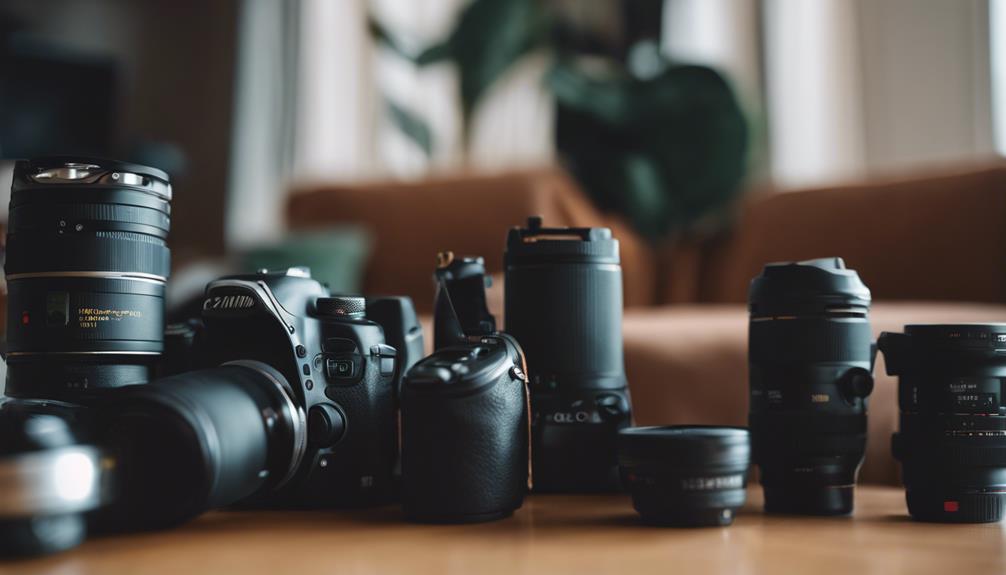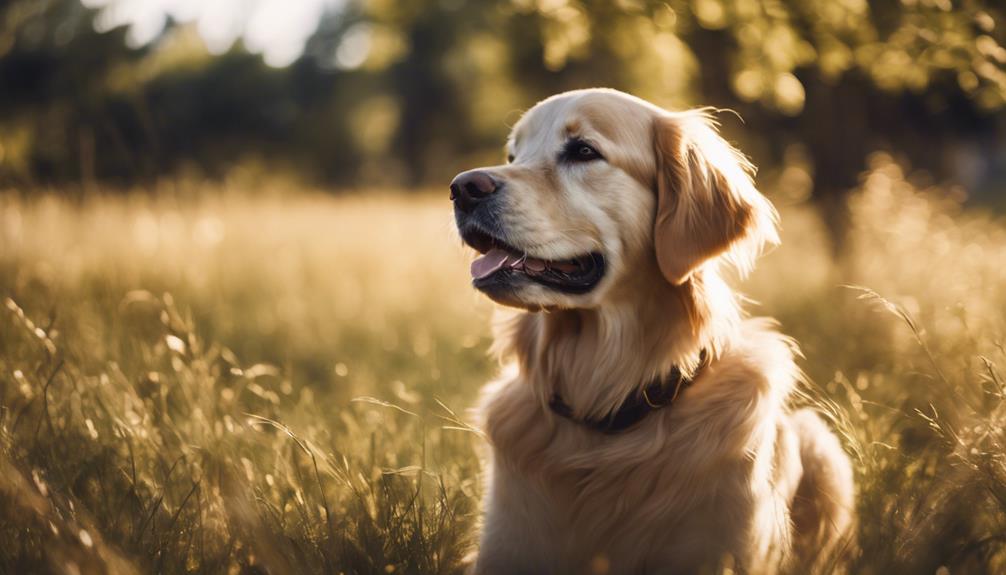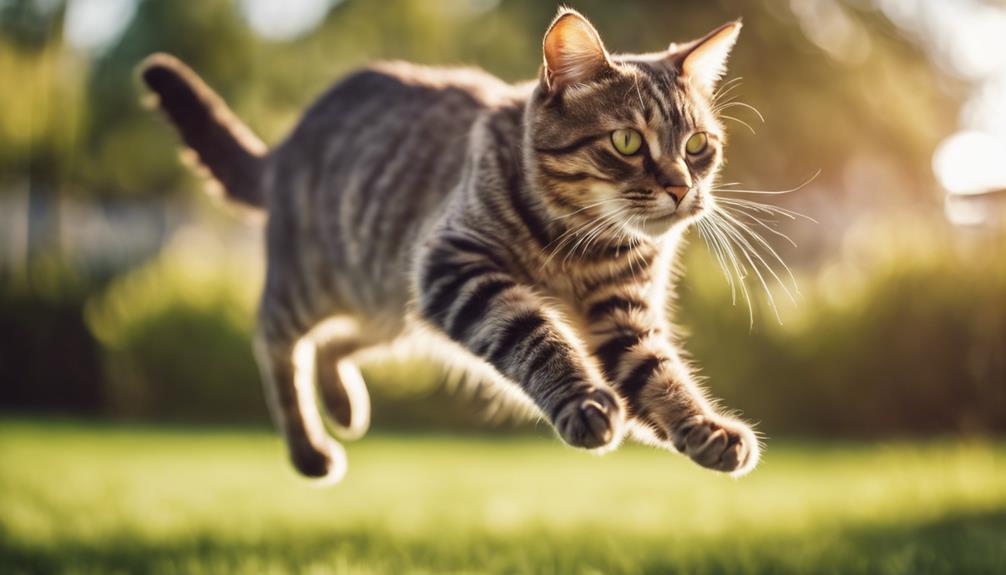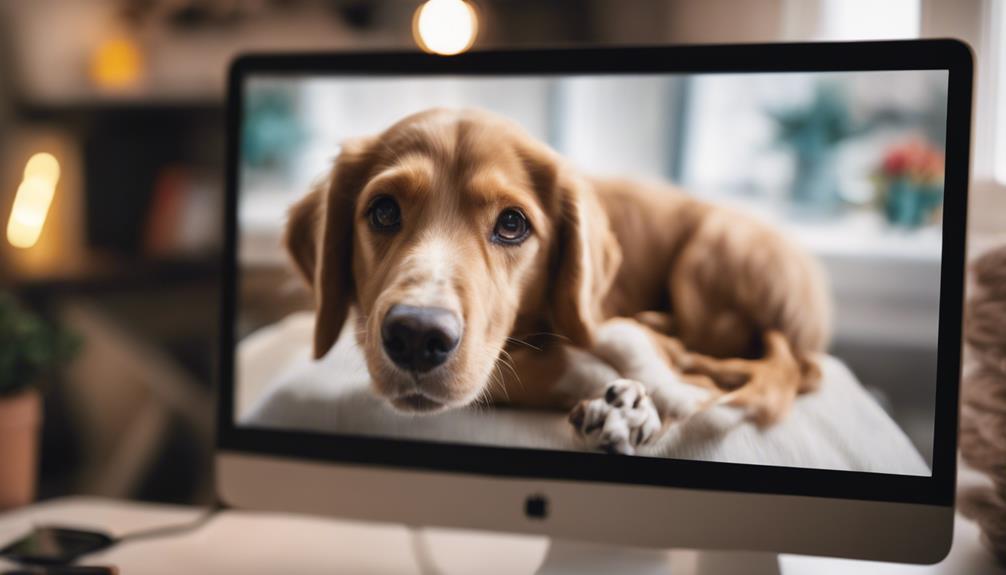To master pet photography and capture candid, adorable photos, you'll need the right approach and gear. Start by setting your camera with a fast shutter speed and a wide aperture to catch sharp, well-exposed images of your lively pet. Opt for a versatile 24-70mm lens or a 50mm prime lens for beautifully natural shots. Understanding your pet's behavior is essential—anticipate their next move, whether they're playing, resting, or exploring, and adjust your position and settings accordingly. Utilize natural light effectively, applying techniques like the Golden hour for a warm glow. Perfect your timing and angles, and soon, you'll uncover more secrets to transforming your furry friends into true photogenic wonders.
Choosing the Right Equipment

Selecting the right camera and lens combo is vital for capturing the sharp, vivid details of your pet's expressions and movements. You'll want to contemplate a camera that allows extensive control over camera settings, such as shutter speed, ISO, and aperture. These elements are essential for adapting to various lighting conditions and the dynamic nature of pet photography.
For lens selection, a versatile 24-70mm zoom lens can be invaluable. It offers wide angles for full-body shots and sufficient zoom for close-up expressions without disturbing your pet. Alternatively, a 50mm prime lens provides a natural look with its capability to produce images that closely resemble what the human eye sees, ideal for those candid shots.
Pay attention to the aperture settings on your lenses; a lens with a wide aperture (low f-number) allows more light into the sensor, helping to keep the focus sharp on your pet while beautifully blurring the background. This creates a professional-looking bokeh effect that emphasizes your furry friend against a softly defocused backdrop.
Adjusting these settings in real-time as you shoot will maximize the impact of your photos, capturing every whisker and wag with clarity and artistic flair.
Understanding Pet Behavior
While mastering the technical aspects of your camera is important, you'll also need to understand your pet's behavior to capture truly engaging images. Recognizing signs of comfort and stress can help you adjust your approach, ensuring your pet's well-being and the quality of your photographs.
Observing your pet's reactions to various stimuli is vital. For instance, pets with noise sensitivity might not react well to the clicking sounds of a camera. In such cases, you might consider using a quieter camera or a remote shutter release to minimize the disturbance.
Training rewards play a significant role in pet photography. These rewards can help your pet associate the photography sessions with positive experiences, making them more cooperative and lively during shoots. Here's a quick guide to understanding common pet behaviors and how you can use them to your advantage:
| Behavior | Tips for Photography |
|---|---|
| Playfulness | Capture action shots with a fast shutter speed. |
| Sleepiness | Use soft lighting for a calm, serene shot. |
| Alertness | Great for striking, attentive poses. |
| Curiosity | Encourage exploration for dynamic angles. |
| Relaxation | Ideal for intimate, close-up portraits. |
Understanding these behaviors will enable you to create a session that is not only productive but also enjoyable for both you and your pet.
Utilizing Natural Lighting

Harnessing natural light can dramatically enhance the authenticity and mood of your pet photography, offering soft, diffuse illumination that flatters your subject's features. The key is to master the timing and angle at which the light interacts with your pet's fur and eyes, capturing the essence of their personality in a single shot.
One of the most magical lighting conditions is the 'Golden hour glow', which occurs just after sunrise and before sunset. During these times, the sun is low in the sky, producing a warm, golden light that isn't only beautiful but also incredibly flattering. Position your pet so that this golden light falls over them, enhancing their fur's natural tones and creating a stunning visual impact.
Additionally, you can experiment with shadow play techniques to add depth and intrigue to your photos. By positioning your pet in areas where shadows intersect with light, you can create striking contrasts and highlight the intricate details of their features. This approach not only captures the eye but also adds a layer of dramatic flair to your compositions.
Perfecting Your Composition
Mastering the art of composition is crucial for transforming ordinary pet snapshots into compelling, eye-catching photographs. You'll find that understanding and applying the rule of thirds can significantly enhance the balance and interest in your images. Imagine dividing your frame into a nine-part grid; now, place your pet at any of the points where the lines intersect. This positioning draws the viewer's eye more naturally than centering your subject would.
Incorporating framing techniques also adds depth and context to your photos. Use doorways, windows, or branches to create a natural frame around your pet, enhancing the focus on them while adding a storytelling element. Be mindful of the background and make sure it isn't too cluttered, which can distract from your main subject.
Pay attention to the edges of your frame as well. It's easy to accidentally cut off a tail or an ear. Double-check your viewfinder or screen before capturing the shot to confirm your pet is fully within the frame in a pleasing composition.
Lastly, don't forget to experiment with different angles and perspectives. Get down to your pet's level; shooting from their viewpoint not only provides an intimate insight into their world but also avoids awkward angles and creates a more impactful emotional connection to your photo.
Capturing Action Shots

Capturing your pet in motion requires a fast shutter speed and keen observation to seize those fleeting, dynamic moments. To start, you'll need to adjust your camera's settings to accommodate the speedy antics of your furry friend. Set your camera to a high shutter speed—something around 1/1000th of a second or faster. This setting is essential as it freezes the action, ensuring that each playful jump or swift run is captured with crisp clarity.
Next, focus on mastering focus techniques. Auto-focus (AF) is helpful, but for better control, switch to Continuous AF (also known as AI Servo AF mode). This allows your camera to continuously adjust the focus as your pet moves, keeping them sharp in every frame. Position yourself parallel to the direction of movement and anticipate where your pet will go next. This proactive approach helps in maintaining a steady focus.
Additionally, utilize burst mode to take multiple shots per second. This increases your chances of capturing that perfect, dynamic pose. Keep your movements minimal and your attention sharp, ensuring your camera is always ready to snap those vibrant, action-packed images. Remember, practice makes perfect, so don't hesitate to keep trying until you get those stunning, lively shots.
Tips for Patient Photography
While capturing action shots requires speed, photographing your pet patiently involves waiting for the right moment when they reveal their most relaxed or natural state. This method allows you to capture the essence and soulful expressions that make each photo a cherished memory. Patience in pet photography isn't just about sitting quietly; it's an active, engaged process where you're constantly observing and reacting to your pet's mood and environment.
Here are some effective strategies to enhance your patient photography:
- Use distraction techniques: Softly play with toys or use gentle sounds to subtly direct your pet's attention without overwhelming them. This keeps their curiosity piqued and allows for natural-looking shots.
- Implement a reward system: Treats can be a powerful motivator. Reward your pet for their patience and calm demeanor. This not only keeps them content but also reinforces positive behavior, making future photo sessions easier.
- Create a calm environment: Minimize noise and keep the setting serene. A relaxed pet is more likely to stay put and show off their genuine personality.
Editing Your Pet Photos

Once you've captured your pet's perfect moment, editing can transform the raw image into a stunning portrait that highlights their unique personality. Start by utilizing color grading to enhance or subtly change the mood of the photo. This process adjusts the colors to make them warmer for a cozy feel or cooler for a more serene vibe. Then, consider background removal to eliminate any distractions that detract from your pet's adorable features.
Here's a handy table to guide you through the essential tools and their functions:
| Tool | Function |
|---|---|
| Color Grading | Adjust color tones for mood enhancement |
| Background Removal | Clear distracting elements from the scene |
| Brightness/Contrast | Fine-tune the light and shadows |
| Crop and Compose | Focus the viewer's attention on the subject |
Pay close attention to the brightness and contrast settings. You'll want to balance these to make sure your pet's fur texture and color are vivid but natural. Cropping is also important; it helps in composing the photo more effectively, placing your pet in just the right spot within the frame to catch the eye.
Frequently Asked Questions
How Do I Manage Multiple Pets in One Photo Shoot?
To manage multiple pets in one photo shoot, you'll want to master scheduling strategies and attention techniques. Plan your session when they're typically calmest, perhaps after a meal or exercise.
Use individual toys or treats to capture each pet's attention sequentially, rather than all at once. This method helps in minimizing distractions and maintaining a composed setting.
Patience is key; allow each pet their moment to shine individually for the best results.
Are Treats or Toys More Effective for Keeping Pets Engaged?
To keep pets engaged during a photoshoot, it's important to use attention tricks. Treats work like magic, mesmerizing pets and holding their focus better than toys typically do.
This engagement technique allows for sharper, more expressive shots. Treats provide a simple, yet effective method to direct and maintain their attention, which is essential for capturing those perfect, spontaneous moments that highlight their personalities in the most artistic and technically sound way.
What Are Common Pet Photography Mistakes to Avoid?
When tackling pet photography, you'll want to sidestep a few common errors to make sure your shots are stunning. Poor lighting can ruin an otherwise perfect moment by obscuring details or causing unwanted shadows.
You should also watch out for incorrect focus; nothing's more frustrating than having your pet's eyes blurred while their tail is sharp. Aim for clarity by adjusting your focus point meticulously, making certain your pet's eyes are the sharpest feature.
How Do I Ensure Pet Safety During a Photo Session?
Ensuring your pet's safety during a photo session isn't just vital; it's a must.
First, choose a location where they feel secure and relaxed. Comfortable environments greatly minimize risks.
Don't overlook the importance of using appropriate safety gear, especially if you're shooting in potentially hazardous settings.
Always keep a close eye on their behavior and body language to detect any signs of stress or discomfort.
Safety first, to keep the session fun and fruitful!
What's the Best Season for Outdoor Pet Photography?
For outdoor pet photography, spring and fall typically offer the best natural lighting, avoiding harsh summer sun or dim winter days.
However, you'll need to take into account potential lighting challenges, like the position of the sun during golden hours.
Additionally, be mindful of seasonal allergies that may affect your pet.
Choosing a season when your pet is most comfortable and the light complements your artistic vision will result in stunning, natural photos.
Conclusion
Just as a painter blends colors on a canvas, you'll blend light, shadow, and emotion in your pet photography.
Remember, each snapshot is a brushstroke that contributes to the masterpiece of your pet's story.
Harness natural light as your ally, frame each moment with a keen eye, and let patience guide your shutter's release.
Editing is your final touch, subtly enhancing each detail.
Together, these techniques transform simple pet photos into vivid portraits that capture the essence of your furry companion.
